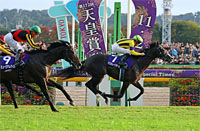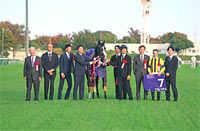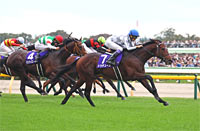Tenno Sho (Autumn) (G1) - Data Analysis
Race that determines the middle-distance champion of the autumn season
The Tenno Sho (Autumn) is one of the top attractions at Tokyo Racecourse of the autumn season, and as such needs no introduction. The two previous winners, Equinox in 2022 and Efforia in 2021, both triumphed in the Arima Kinen (The Grand Prix) in their next race, while 2020 winner Almond Eye went on to take the crown in the subsequent Japan Cup. In the year they secured their victory in the Tenno Sho (Autumn), these three runners were also all voted JRA’s Horse of the Year. Below, we look for some trends in this must-watch race based on the data for the last 10 years.
Battle between runners aged 5 or below
No runners aged 6 or above have finished in the Top 3 since 2013, when 6-year-old Eishin Flash secured third place. This suggests we should basically view this race as a contest between runners aged 5 or below. Although fewer in overall number, 3-year-olds have also performed favorably over the last 10 years, with Efforia and Equinox securing consecutive wins in 2021 and 2022, respectively. If any 3-year-olds have skipped last week’s Kikuka Sho (Japanese St. Leger) to compete against older horses in this race, we should check them out. [Table 1]
[Table 1] Performance by age (last 10 years)
| Age |
Performance
[1st-2nd-3rd-4th or lower] |
Win ratio |
Top 2 ratio |
Top 3 ratio |
| 3 |
2-0-2-8 |
16.7% |
16.7% |
33.3% |
| 4 |
3-6-4-30 |
7.0% |
20.9% |
30.2% |
| 5 |
5-4-3-38 |
10.0% |
18.0% |
24.0% |
| 6 or above |
0-0-1-51 |
0% |
0% |
1.9% |
High success ratios for fillies and mares
Fillies and mares have achieved significantly higher success ratios than colts, horses, and geldings over the last 10 years. We should therefore keep an eye on fillies and mares that choose to compete in this race against colts, horses, and geldings rather than in the fillies-and-mares-only Queen Elizabeth II Cup two weeks from now. [Table 2]
[Table 2] Performance by gender (last 10 years)
| Gender |
Performance
[1st-2nd-3rd-4th or lower] |
Win ratio |
Top 2 ratio |
Top 3 ratio |
Colts, horses,
and geldings |
8-8-7-117 |
5.7% |
11.4% |
16.4% |
| Mares and fillies |
2-2-3-10 |
11.8% |
23.5% |
41.2% |
Runners starting in inner brackets enjoy success
Because the 2,000m turf track at Tokyo Racecourse has a corner immediately after the starting gate, runners starting in the outer brackets are said to be at a strategic disadvantage. This trend is apparent in the data, as horses with horse number 10 or below have produced all winners over the last 10 years. It is therefore advisable to pick runners entering the race with horse number 1-9. [Table 3]
[Table 3] Performance by horse number (last 10 years)
| Horse number |
Performance
[1st-2nd-3rd-4th or lower] |
Win ratio |
Top 2 ratio |
Top 3 ratio |
| 1-9 |
10-8-6-65 |
11.2% |
20.2% |
27.0% |
| 10-18 |
0-2-4-62 |
0% |
2.9% |
8.8% |
Watch runners coming straight from spring G1 races
In the past, runners that had contested another race following the summer break delivered strong performance. More recently, however, runners who entered the Tenno Sho (Autumn) as their first race of the autumn season have achieved higher success ratios. Runners coming straight from spring G1 races achieved an excellent Top 3 ratio of 44.4% over the last 10 years. Within this group, those that had previously contested the Yasuda Kinen achieved a Top 3 ratio of 62.5%. Other runners that put up a decent fight were those that had contested a G2 race in their previous race. Conversely, runners that had entered a G3 or open-class race last time out produced zero Top 3 finishers over the last 10 years. [Table 4]
[Table 4] Performance by previous race (last 10 years)
| Previous race |
Performance
[1st-2nd-3rd-4th or lower] |
Win ratio |
Top 2 ratio |
Top 3 ratio |
| G1 |
5-7-4-20 |
13.9% |
33.3% |
44.4% |
| G2 |
5-3-6-88 |
4.9% |
7.8% |
13.7% |
| G3 |
0-0-0-12 |
0% |
0% |
0% |
| Open-class race |
0-0-0-3 |
0% |
0% |
0% |
| Overseas race |
0-0-0-4 |
0% |
0% |
0% |
Target runners with Top 3 finish in previous race
Looking at performances by runners over the last 10 years in terms of finish in the previous race, we find some examples of rebound performances such as 2017 winner Kitasan Black, who bounced back from a 9th-place finish in the Takarazuka Kinen. However, runners that had finished in the Top 3 of their previous race delivered the most consistent performance. In particular, among runners that had contested a G2 race in their previous race, those that had not achieved a Top 3 finish in that race struggled, and runners that had finished 4th or lower in a G2 race last time out delivered performance of [0-1-1-54], translating into a Top 3 ratio of only 3.6%. [Table 5]
[Table 5] Performance by finish in previous race (last 10 years)
| Finish in previous race |
Performance
[1st-2nd-3rd-4th or lower] |
Win ratio |
Top 2 ratio |
Top 3 ratio |
| Top 3 |
9-6-7-51 |
12.3% |
20.5% |
30.1% |
| 4th or lower |
1-4-3-76 |
1.2% |
6.0% |
9.5% |
Seek out the winner!
Highly favored runners have the edge
While race favorites at one point suffered 12 consecutive defeats, they have turned in strong performance in recent years, with the last eight winners all being backed by win odds of 4.0 or lower. One trend that stands out is that these winners were ridden by either a non-Japanese or top-ranked jockey. Another shared feature is that they had all been backed as 2nd favorite or higher in their previous race. [Table 6]
[Table 6] Winners’ win odds, jockey, and favoritism in previous race (last eight years)
| Year |
Winner |
Win odds |
Jockey |
Favoritism in previous race |
| 2015 |
Lovely Day |
3.4 |
Suguru Hamanaka |
1st favorite |
| 2016 |
Maurice |
3.6 |
Ryan Moore |
1st favorite |
| 2017 |
Kitasan Black |
3.1 |
Yutaka Take |
1st favorite |
| 2018 |
Rey de Oro |
3.1 |
Christophe Lemaire |
1st favorite |
| 2019 |
Almond Eye |
1.6 |
Christophe Lemaire |
1st favorite |
| 2020 |
Almond Eye |
1.4 |
Christophe Lemaire |
1st favorite |
| 2021 |
Efforia |
3.4 |
Takeshi Yokoyama |
1st favorite |
| 2022 |
Equinox |
2.6 |
Christophe Lemaire |
2nd favorite |
(Yodohito Himezono)
|


















